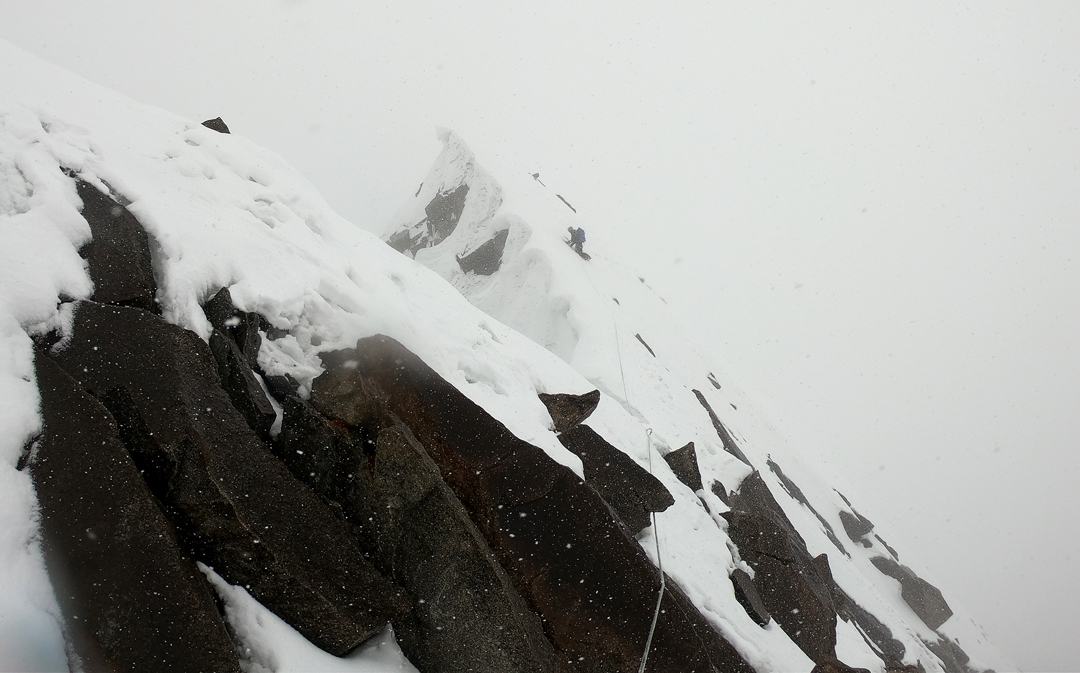Muztagh Tower, Black Tooth, East Ridge and Traverse
Pakistan, Karakoram, Baltoro Muztagh

Philipp Brugger, Martin Sieberer (both from Austria), and I trekked up the Baltoro Glacier in July with the intention of making the first ascent of Muztagh Tower's Black Tooth (6,719m). In 2016 two Germans attempted the ascent via the southeast ridge (AAJ 2017) but retreated in bad weather. Impressed, we thought we could at least give it a try.
We established base camp at 4,500m at the entrance to the Younghusband Glacier, and to acclimatize climbed to 5,200m on the lower part of the (rocky) ridge. It became totally clear that our anticipated route along the crest was impossible. The rock was simply too loose—massive, detached, hanging boulders would have killed us. After a comfortable bivouac we returned to base camp. A new approach would be needed.
Although June in the Karakoram had untypical poor weather, with avalanches that killed pack animals and stranded porters, July had fantastic weather but with rapidly escalating temperatures. There was no time to lose! We set off the very next day, July 19, to find a way through the Dre Glacier below the south face, eventually following the far right side, the same route used by the French expedition that in 1956 made the second ascent of Muztagh Tower, via the upper southeast ridge, a route still unrepeated. A steep 20m pitch of black ice (WI5+) led to easy but crevassed terrain, which we followed to below the south face of the tooth. On the way down from this reconnaissance, we left a rope fixed on the steep section.
Although not yet sufficiently acclimatized, we were prompted by a good forecast to take only one rest day and leave base camp on July 21, before the next spell of bad weather arrived. Regaining our high point, we continued up the south face, which, after the first steep snowfield, became more and more rocky (M4+). By midday, steep wet snow and the high temperature forced us to stop and bivouac. Next day we went all the way down to base camp to reconsider.
The forecast was for increasing cloud over the next four days and then a long period of snowfall. Again, we rested only one day in base camp, then started back up, planning to climb at night and early morning, resting during the day. Philipp, who had not been to high altitudes previously, decided to remain behind.
At 1 a.m. on the 24th, we woke and discovered our cook had overslept, so breakfast was a shared Snickers bar and a few sips of Coca-Cola, the only unfrozen liquid we could find. Climbing through the night, we made 1,200m of ascent to our previous bivouac spot, arriving at 8 a.m.

Tired, we opted to stay until it was light enough to see on the following morning. Starting out unroped, we climbed mixed ground (M4+ maximum) and reached the upper snowfield at dawn. Damn! It was steeper than expected. With Martin in the lead, we continued simul-climbing for 250m up 55–60° ice of poor quality. It felt so precarious that when the sun hit the slope we were unable to pause and get our sunglasses out of our packs and just had to squint. Finally, we reached the upper ridge. It was only 8.30 a.m., but we were too tired to continue. Also, we realized that our planned descent, rappelling the face from Abalakov anchors, was now out of the question, due to the unstable ice. We downclimbed the ridge for 60m to find a flat bivouac site; although not big enough for the tent, this at least allowed us to lie down. Realizing we would have to traverse the summit, we decided that next day we would abandon the tent and everything else we could spare, in order to save weight.
We began shortly after 4 a.m. on July 26. A steep section of M4+ led to a rock tower, which we climbed directly at M5. The angle eased, but the snow remained bad, and we had to pitch all the way to the summit, where we arrived at 1 p.m. By this time it had already been snowing several hours. We traversed summit slopes covered with loose snow, then rappelled to the col between the Tooth and Muztagh Tower. From here we rappelled straight down the south face in thick mist. After the sixth rappel there was a brief clearing and we saw we were on the right route. [From the col, the pair more or less descended the line of the original French route.]
Downclimbing and rappelling where necessary, ropes, gloves, and clothes now frozen, we reached a point at sunset where we had just one small rock peg left for an anchor. Martin drove it into a rock embedded in the snow. I was too tired to check its placement and just clipped myself in. The moment Martin started to rappel, I felt a hard pull on my harness. I was staring into Martin's perplexed, wide-open eyes. The piton had pulled, nearly taking us both down. “Damn! We need to stay concentrated!” I said, knowing he was well aware of this.
We reached the foot of the face absolutely exhausted, and after melting snow to give our bodies much-needed liquid, we decided to continue to base camp. Fresh avalanches had swept our tracks on the glacier, making route-finding difficult, and we didn’t reach camp until 3 a.m. the following morning. We had been lucky: The weather turned bad for days. On the morning of the 28th we left base camp in the rain, with all our gear still wet. But we were safe now—all we had to do was walk.
— Simon Messner, Italy







